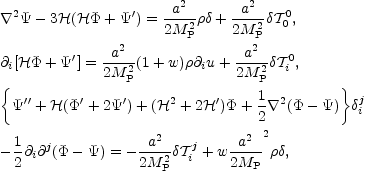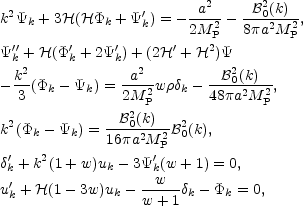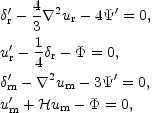


8.1. Large-scale magnetic fields and CMB anisotropies
Large scale magnetic fields present prior to
the recombination epoch may act as a source term in the evolution
equation of the cosmological perturbations. If
magnetic fields are created over large length scales
(possibly even larger than the Mpc) it is rather plausible that they
may be present after matter-radiation equality (but before decoupling)
when primordial fluctuations are imprinted on the CMB
anisotropies. In fact, the relevant modes determining
the large scale temperature anisotropies are the ones that are outside
the horizon for
 eq <
eq <
 <
<
 dec
where
dec
where
 eq
and
eq
and  dec
are, respectively, the equality
and the decoupling times. After equality there are two complementary
approaches which can be used in order to address phenomenological
implications of large scale magnetic fields:
dec
are, respectively, the equality
and the decoupling times. After equality there are two complementary
approaches which can be used in order to address phenomenological
implications of large scale magnetic fields:
large scale magnetic fields are completely homogeneous outside the horizon after equality;
large scale magnetic fields are inhomogeneous after equality.
The idea that homogeneous magnetic fields may affect the CMB anisotropies was originally pointed out by Zeldovich [284, 285] and further scrutinized by Grishchuk, Doroshkevich and Novikov [286]. Since this idea implies that large-scale magnetic fields are weakly gravitating the details of the discussion (and of the possible generalization of this idea) will be postponed to the following Section.
The suggestion that inhomogeneous magnetic fields created during inflation may affect the CMB anisotropies was originally proposed in [289]. In [289] it was noticed that large scale magnetic fields produced during inflation may also lead to large fluctuations for modes which are outside the horizon after equality. In [289] it was noticed that either the produced magnetic fields may be used to seed directly the CMB anisotropies, or, in a complementary persepective, the CMB data can be used to put constraints on the production mechanism.
If large-scale magnetic fields are inhomogeneous, their energy momentum tensor will have, in general terms, scalar, vector and tensor modes
 |
(8.1) |
which are decoupled and which act as source terms for the scalar, vector and tensor modes of the geometry
 |
(8.2) |
whose gauge-invariant description is well explored [199, 200] (see also [201]). The effect of the scalar component of large scale magnetic fields should be responsible, according to the suggestion of [289], of the large scale temperature anisotropies. The direct seeding of large-scale temperature anisotropies seems unlikely. In fact, the spectrum of large scale gauge fields leading to plausible values of the magnetic energy density over the scale of protogalactic collapse is typically smaller than the value required by experimental data. However, even if the primordial spectrum of magnetic fields would be tailored in an appropriate way, the initial conditions for the plasma evolution compatible with the presence of a sizable (but undercritical) magnetic field are of isocurvature type [290].
In order to illustrate this point consider
the evolution equations for the gauge-invariant system of scalar
perturbations of the geometry expressed in terms
of the two Bardeen potential
 and
and
 corresponding, in the
Newtonian gauge, to the fluctuations of the temporal and spatial component
of the metric
[200,
201].
The linearization of the (00), (0i) and (i, j)
components of the Einstein equations leads, respectively, to:
corresponding, in the
Newtonian gauge, to the fluctuations of the temporal and spatial component
of the metric
[200,
201].
The linearization of the (00), (0i) and (i, j)
components of the Einstein equations leads, respectively, to:
 |
(8.3)
(8.5) |
where  =
=

 /
/
 and w =
p /
and w =
p /  is
the usual barotropic index, and
is
the usual barotropic index, and
 |
(8.6) |
are the fluctuations of the energy-momentum tensor of the magnetic field. Eqs. (9.10)-(8.5) have to be supplemented by the perturbation of the covariant conservation equations for the fluid sources:
 |
(8.7) (8.8) |
If the magnetic field is force-free, i.e.
 ×
×
 ×
×
 the above
system simplifies. Notice that Eq. (8.8) has been already written in the
case where the Lorentz force is absent. However, the forcing
term appears, in the resistive MHD approximation, in Eq. (8.6). The term
the above
system simplifies. Notice that Eq. (8.8) has been already written in the
case where the Lorentz force is absent. However, the forcing
term appears, in the resistive MHD approximation, in Eq. (8.6). The term
 ×
×
 ×
×
 is suppressed by the conductivity, however, it can be also set exactly
to zero. In this case, vector identities imply
is suppressed by the conductivity, however, it can be also set exactly
to zero. In this case, vector identities imply
 |
(8.9) |
i.e.  m
m
 i
i
 m =
m =
 m
m
 m
m
 i.
With this identity in mind the system of Eqs. (8.3)-(8.5) and (8.7)-(8.8)
can be written, in Fourier space, as
i.
With this identity in mind the system of Eqs. (8.3)-(8.5) and (8.7)-(8.8)
can be written, in Fourier space, as
 |
(8.10)
|
where
 |
(8.15) |
Combining Eqs. (8.10)-(8.11) with Eq. (8.12) the following decoupled equation can be obtained
 |
(8.16) |
Consider, for simplicity, the dark-matter radiation fluid after equality and in the presence of a force-free magnetic field. In this case Eq. (8.16) can be immediately integrated:
 |
(8.17) |
The solutions given in Eq. (8.17) determine the source of the density and velocity fluctuations in the plasma, i.e.
 |
(8.18) (8.19) (8.20) (8.21) |
The solution for the velocity fields and density contrasts can be easily obtained by integrating Eqs. (8.18)-(8.21) with the source terms determined by Eq. (8.17). The purpose is not to integrate here this system (see for instance [291] for the standard case without magnetic fields). Rather it is important to notice that there are two qualitatively different situation. The first situation is the one where,
 |
(8.22) |
namely the case where the constant mode of the Bardeen potential is negligible if compared to the contribution of the magnetic field. The derivative of the Bardeen potential will be, however, non vanishing. In this case the CMB anisotropies are said to be seeded by isocurvature initial conditions for the fluid of radiation and dark-matter present after equality. In the opposite case, nemely
 |
(8.23) |
the constant mode of the Bardeen potential is provided, for instance, by
inflation and the magnetic field represent a further parameter to be
taken into account in the analysis of CMB anisotropies. Assuming,
roughly, that
| 0(k)|
~ 10-6, Eq. (8.23) implies that for the typical
scale of the horizon at decoupling the critical fraction of magnetic
energy density should be smaller than 10-3.
In the case of Eq. (8.23) the leading order relations among the
different hydrodynamical
fluctuations are well known and can be obtained from Eqs. (8.18)-(8.21)
if the magnetic field is approximately negligible, i.e.
0(k)|
~ 10-6, Eq. (8.23) implies that for the typical
scale of the horizon at decoupling the critical fraction of magnetic
energy density should be smaller than 10-3.
In the case of Eq. (8.23) the leading order relations among the
different hydrodynamical
fluctuations are well known and can be obtained from Eqs. (8.18)-(8.21)
if the magnetic field is approximately negligible, i.e.
 |
(8.24) |
This result has a simple physical interpretation, and
implies the adiabaticity of the fluid perturbations.
The entropy per matter particle is indeed proportional to
S = T3 / nm, where
nm is the number density of
matter particles and T is the radiation temperature.
The associated entropy fluctuation,
 S, satisfies
S, satisfies
 |
(8.25) |
where we used the fact that
 r ~
T4 and that
r ~
T4 and that
 m =
mnm, where m is the typical mass
of the particles in the matter fluid. Equation (8.24) thus implies
m =
mnm, where m is the typical mass
of the particles in the matter fluid. Equation (8.24) thus implies
 S / S = 0,
in agreement with the adiabaticity of the fluctuations.
S / S = 0,
in agreement with the adiabaticity of the fluctuations.
After having computed the corrections induced by the magnetic field on
the (leading) adiabatic initial condition the temperature anisotropies
can be computed using the Sachs-Wolfe effect
[292].
In terms of the
gauge-invariant variables introduced in the present analysis, the
various contributions to the Sachs-Wolfe effect, along the
 direction, can be written as
direction, can be written as
 |
(8.26) |
where
 0
is the present time, and
0
is the present time, and
 (
( ) =
) =
 0 -
0 -
 (
( -
-
 0)
is the unperturbed photon position
at the time
0)
is the unperturbed photon position
at the time  for an observer
in
for an observer
in  0.
The term
0.
The term
 b is
the peculiar velocity of the baryonic matter component.
b is
the peculiar velocity of the baryonic matter component.
In Fig. 11 the
C are
plotted in the case of models with adiabatic initial conditions.
are
plotted in the case of models with adiabatic initial conditions.
The data points reported in Figs. 11 and 12 are those from COBE [293, 294], BOOMERANG [295], DASI [296], MAXIMA [297] and ARCHEOPS [298]. Notice that the data reported in [298] fill the "gap" between the last COBE points and the points of [295, 296, 297]. In Fig. 12 the recent WMAP data are reported [299, 300, 301].
 |
Figure 12. The WMAP data are reported. |
Recall, that the temperature fluctuations are customarily discussed in terms of their Legendre transform
 |
(8.27) |
where the coefficients
a m define
the angular power spectrum
C
m define
the angular power spectrum
C by
by
 |
(8.28) |
and determine the two-point (scalar) correlation function of the temperature fluctuations, namely
 |
(8.29) |
In Fig. 11 and 12 the
experimental points are presented in terms of the
C spectra.
spectra.
In Fig. 11 and 12 the
curves fitting the data are obtained by imposing adiabatic initial
conditions. If magnetic fields would seed directly the CMB anisotropies
a characteristic "hump" would appear for
 < 100 which is
not compatible with the experimental data. If, on the contrary, the
condition (8.23) holds, then the modifications due to a magnetic
field can be numerically computed for a given magnetic spectral index
and for a given amplitude. This analysis has been performed by Koh and Lee
[302].
The claim is that by modifying the amplitude of the magnetic field in a
way compatible with the cosmological constraint the effect on the scalar
C
< 100 which is
not compatible with the experimental data. If, on the contrary, the
condition (8.23) holds, then the modifications due to a magnetic
field can be numerically computed for a given magnetic spectral index
and for a given amplitude. This analysis has been performed by Koh and Lee
[302].
The claim is that by modifying the amplitude of the magnetic field in a
way compatible with the cosmological constraint the effect on the scalar
C can be
as large as the 10% for a given magnetic spectral index.
can be
as large as the 10% for a given magnetic spectral index.
The main problem is order to detect large-scale magnetic fields from the spectrum of temperature fluctuations is the parameter space. On top of the usual parameters common in the CMB analysis at least two new parameters should be introduced, namely the magnetic spectral index and the amplitude of the magnetic field. The proof of this statement is that there is no available analysis of the WMAP data including also the presence of large scale magnetic fields in the initial conditions according to the lines presented in this Section.
To set bounds on primordial magnetic fields from CMB anisotropies it is
often assumed that the magnetic field is fully homogeneous. In this case
the magnetic field amplitude has been bounded to be
B  10-3 G
at the decoupling time
[303]
(see also [305]
for a complementary analysis always in the case of a homogeneous
magnetic field).
10-3 G
at the decoupling time
[303]
(see also [305]
for a complementary analysis always in the case of a homogeneous
magnetic field).
There is the hope that since magnetic fields contribute not only to the
scalar fluctuations, but also to the vector and tensor modes of the
geometry useful informations cann be also obtained from the analysis of
vector and tensor power spectra. In
[304]
temperature and polarization power spectra induced by vector and tensor
perturbations have been computed by assuning a power-law spectrum of
magnetic inhomogeneities.
In [306,
307,
308]
the tensor modes of the geometry have
been specifically investigated.
In [309,
310,
311]
it is argued that magnetic fields can induce
anisotropies in the polarization for rather small length scales, i.e.
 > 1000.
> 1000.
As already pointed out in the present Section, magnetic fields may be assumed to be force free in various cases. This is an approximation which may also be relaxed. However, even if magnetic fields are assumed to be force-free there is no reason to assume that their associated magnetic helicity (or gyrotropy) vanishes. In [312] the posssible effects of helical magnetic fields on CMB physics have been investigated. If helical flows are present at recombination, they would produce parity violating temperature-polarization correlations. The magnitude of helical flows induced by helical magnetic fields turns out to be unobservably small, but better prospects of constraining helical magnetic fields come from maps of Faraday rotation measurements of the CMB [312].